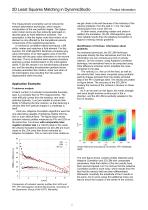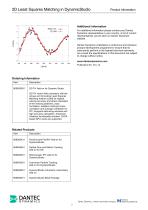
Catalog excerpts

Applications • Particle Image Velocimetry • Stereoscopic PIV • Flow with high velocity gradients • T urbulent flow analysis • Analysis of vortical structures Features • Precise velocity calculation • Direct velocity gradient calculation • Physical flow modelling • Accurate vortex identification Left: Velocity field inside of a vortex calculated with 2D LSM. Right: Lambda2 vorticity criterion computed with the estimated flow gradients. Introduction For more than 25 years, the cross-correlation operator has been used to calculate the velocity field from pairs of particle images. During these years much effort has been made to improve the quality of the results. Multi-grid methods were implemented to increase the spatial resolution. Multi-step schemes with successively decreasing interrogation area size were deployed to handle larger velocity ranges and to increase the dynamic range of Particle Image velocimetry. Deforming windows techniques were introduced to better accommodate for velocity gradients. High-accuracy methods were proposed to alleviate the effect known as peak locking. But the fundamental concept of cross-correlation as displacement estimator was never really challenged until today. For the first time ever, Least Squares Matching (LSM) brings flow physics to the processing of particle images. Unlike cross-correlation, LSM uses a model to describe the movement of fluid elements. This model contains six parameters describing translation, scale, rotation and shear of the interrogation areas. The six affine transformation parameters are obtained in an iterative manner and converge to the correct solution within a few iterations. The benefit is that not only the velocity is calculated, but in addition the velocity gradients are directly computed without introducing noise, which is an unfortunate by-product of using traditional difference schemes. Least Squares Matching The fundamental theorem of Helmholtz states that every infinitesimal motion of a fluid element can be decomposed in translation, rotation and deformation. In the last decades several investigations have been performed to experimentally describe these fluid motions. In classical PIV based on correlation techniques, 2D cross-correlation is most frequently applied to extract the zero order translational velocity components, neglecting the higher order terms of rotation and deformation. The assumption is that the flow field is smooth and not significantly influenced by rotational or shear displacements, thus yielding the zero-order translational displacement field with an additional measurement uncertainty due to neglecting the higher-order terms. DANTECDYNAMICS NOVA ■M INSTRUMENTS
Open the catalog to page 1
2D Least Squares Matching in DynamicStudio Product Information we get closer to the wall because of the intensity of the velocity gradients: from the wall to 1 mm, the mean velocity goes from null to 350 m/s. In other words, evaluating rotation and shear in addition the translation, the 2D LSM algorithm gives more reliable results than the Adaptive Correlation in regions of strong velocity gradients. The measurement uncertainty can be reduced by window deformation techniques, which require manipulation of the raw particle images. The higherorder motion terms are then indirectly estimated on...
Open the catalog to page 2
Product Information 2D Least Squares Matching in DynamicStudio Additional information For additional information please contact your Dantec Dynamics representative in your country. A list of current representatives can be seen on Dantec Dynamics' website. Dantec Dynamics undertakes a continuous and intensive product development programme to ensure that its instruments perform to the highest technical standards. As a result the specifications in this document are subject to change without notice. www.dantecdynamics.com Publication No: 310 v2 Ordering Information DANTEC DYNAMICS |k | NOVA...
Open the catalog to page 3All Dantec Dynamics A/S catalogs and technical brochures
-
F-Q-480
2 Pages
-
F-Q-400TCT
2 Pages
-
Q-400 μDICTM
2 Pages
-
5 Beam 112mm probe
2 Pages
-
LabVIEW Toolbox for CTA
2 Pages
-
DynamicStudio Base Package
5 Pages
-
Flow Field
8 Pages
-
HiSense 600 series
2 Pages
-
FlowSense EO
4 Pages
-
HiSense Zyla
2 Pages
-
ComfortSense Mini
4 Pages
-
DISATAC Tachometers
56 Pages
-
Laser Doppler Anemometry
8 Pages
-
Probes for hot-wire anemometry
25 Pages
-
FlowExplorer compact LDA
2 Pages
-
DynamicStudio
8 Pages
-
Spray Diagnostics Solutions
8 Pages
-
Wind Turbine Optimization
8 Pages
-
Laser shearography (Q-800)
2 Pages
-
Q-501 Real Time Mode Monitor
2 Pages
-
PDA systems
8 Pages








































